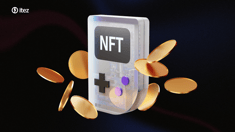
The potential behaviour of cryptocurrencies is influenced by a range of factors, including investor sentiment, which can be analysed using the Fear and Greed Index. In this article, we explain how this tool works and how to interpret it.
What is the Fear and Greed Index?
Overview and History
The Fear and Greed Index is a tool that helps investors assess the market's potential based on the emotions of its participants. It was introduced by CNN Money in 2012.
Originally designed for the stock market, the Fear and Greed Index was later adapted for cryptocurrencies by the company Alternative.me.
How the Index is Calculated
The Fear and Greed Index is a scale from 0 to 100, where 0 represents maximum fear and 100 represents maximum greed. A middle score of 50 indicates a neutral sentiment in the market.
Crypto Fear and Greed Index. Source: Alternative.me
The index is updated daily, and you can track its readings through a dedicated link. For example, today, April 9th, the index stands at 18. This indicates extreme fear, primarily driven by Donald Trump's trade war developments.
Components of the Fear and Greed Index
The Fear and Greed Index is calculated based on several factors, each contributing a specific percentage. Let’s take a look at these components:
25% – Volatility. This factor measures the average Bitcoin price (the largest cryptocurrency by market capitalisation) over 30 and 90 days. It helps determine the market's certainty level, showing whether there are active purchases, sales, or if the market is stagnant.
25% – Momentum and Market Volume. The index compares Bitcoin’s trading volume and market activity over the last 30 and 90 days. The result helps evaluate the activity of buyers and sellers, indicating whether positive or negative sentiment is prevailing.
15% – Mentions of Cryptocurrency in Social Media. This factor tracks hashtags on Twitter. An increase in mentions often points to heightened interest in cryptocurrencies, which generally reflects growing greed.
10% – Bitcoin Dominance. A rise in Bitcoin dominance suggests an influx of new investors and potential redistribution of funds in the market.
10% – Google Trends Analysis. This component uses search data from Google Trends to assess market sentiment. For example, a rise in searches related to cryptocurrency scams may indicate increasing fear within the crypto space.
15% – Poll Results. According to the official site of the Fear and Greed Index, this factor is temporarily excluded from the calculations.
How to Interpret the Fear and Greed Index
To interpret the index, let’s apply some logic: the more fear there is about cryptocurrency, the fewer buyers there will be, as investors are hesitant to purchase assets they feel uncertain about. However, extreme fear readings can indicate a good entry point for long-term investors looking to capitalise on a potential rebound.
Conversely, extreme greed can signal that the cryptocurrency market is overheating, with the risk of prices eventually falling. Here’s how the index breaks down:
0–24: Extreme Fear (Orange). This can occur when the market experiences sharp declines or major losses. Investors are typically anxious and tend to pull their investments out of the market. For many, this is a time of heightened risk and caution. However, extreme fear can sometimes create buying opportunities for savvy traders who recognise the potential for a market rebound.
25–49: Fear (Yellow). At this level, there’s still fear in the market, but less extreme. Investors are cautious, and market movements are influenced by uncertainty.
50–74: Greed (Light Green). This range suggests a more balanced market, where neither extreme fear nor excessive greed dominates. Traders may consider this a time for normal market activity with less risk of sudden price swings.
75–100: Extreme Greed (Green). When the index reaches this level, investors may become overly optimistic, buying without fully considering the risks. This often happens during market booms or when a particular asset shows rapid price increases. While it may seem tempting to follow the crowd, extreme greed often signals that the market is overbought and could soon face a correction.
Viewing how the index signals work can be helpful when overlaid on Bitcoin’s price chart. Typically, the peak values for Bitcoin coincide with extreme greed, while the troughs align with extreme fear.
Using the Index for Timing Market Entries and Exits
One of the most valuable aspects of the Fear and Greed Index is its ability to guide market entry and exit points.
Market Entry. When the index shows extreme fear, it might indicate that the market is oversold. For traders, this could be a signal to enter the market, as prices are low and a rebound may be imminent.
Market Exit. On the flip side, when the index shows extreme greed, it could be a sign that the market is overbought. This might be a good time for traders to lock in profits and prepare for a potential downturn.
By using the Fear and Greed Index in conjunction with other tools, traders can improve the accuracy of their market timing.
Practical Applications in Trading
The Fear and Greed Index isn't just an abstract concept; it has real-world applications for traders. Let's explore a few strategies for using the index effectively.
Contrarian Trading Strategies
A contrarian trader takes the opposite approach to the prevailing market sentiment. If the Fear and Greed Index shows extreme fear, a contrarian trader might see it as a buying signal. Conversely, if extreme greed is present, they might consider selling.
This approach requires a strong understanding of market cycles and a willingness to go against the crowd. While contrarian trading can be risky, it can also be highly rewarding during periods of market overreaction.
Combining with Other Indicators
While the Fear and Greed Index is a useful tool, it’s not foolproof on its own. Many experienced traders combine it with other technical and fundamental indicators to enhance their decision-making process. For example, traders might use the Relative Strength Index (RSI) or Moving Averages (MA) alongside the Fear and Greed Index to confirm signals.
Using multiple indicators helps traders confirm trends and avoid false signals that could arise from relying on a single source of information.
The Fear and Greed Index in Cryptocurrency Markets
Cryptocurrency markets are known for their volatility, and the Fear and Greed Index plays a crucial role in helping traders navigate these wild swings.
Differences Between Crypto and Stock Market Sentiments
The cryptocurrency market is often more volatile than traditional stock markets. This is partly due to the relatively small size of the market, the speculative nature of crypto assets, and the influence of social media and news cycles. As a result, extreme fear or greed can occur much more frequently in the crypto market compared to traditional equities.
While the Fear and Greed Index is effective in both markets, its readings can be more extreme in the crypto world, reflecting the heightened emotions of investors. This can make cryptocurrency markets a bit trickier to read, but also presents unique opportunities for traders who can manage the volatility.
Using the Index in Crypto Trading
In cryptocurrency trading, the Fear and Greed Index is particularly useful for determining the right time to enter or exit the market. Given the frequent price swings in the crypto space, using the index can help traders identify trends and sentiment shifts that may not be immediately obvious from price action alone.
Traders can also use the index to gauge how external factors, such as regulatory news or technological advancements, might be influencing market sentiment.
Conclusion
The Fear and Greed Index is a valuable tool for understanding market sentiment. By tracking the emotions of fear and greed, traders can make more informed decisions about when to enter or exit the market. Extreme fear can signal buying opportunities, while extreme greed may indicate it's time to sell.
Sentiment analysis is a critical aspect of trading, especially in volatile markets like cryptocurrencies. By using the Fear and Greed Index alongside other technical indicators, traders can develop more effective strategies and minimise risk. Whether you're a beginner or an experienced trader, understanding market sentiment is essential for long-term success.
🤔 Do you want to try Fear and Greed Index? Share your views in our socials!
💌 Telegram, Twitter, Instagram, Facebook
Here are three other cool articles:
Top 5 Cryptocurrencies in 2024
Top 5 Crypto Events That Shaped the Market Momentum in 2024
This article is not investment advice or a recommendation to purchase any specific product or service. The financial transactions mentioned in the article are not a guide to action. It’s not intended to constitute a comprehensive statement of all possible risks. You should independently conduct an analysis on the basis of which it will be possible to draw conclusions and make decisions about making any operations with cryptocurrency.








